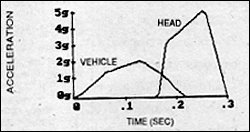When the lead vehicle is struck from the rear and is easily accelerated, the inertia of the head of the occupant of the lead vehicle resists acceleration and the neck snaps back with tremendous force.6 (Figure 3) This overextended position then induces a reflex contraction of the occupant's neck musculature, causing the head and neck of the occupant to be catapulted forward with rotational and translational accelerations higher than those of the vehicle itself.3

McKenzie4 has indicated that a definite relationship exists between the rate of acceleration of the lead vehicle and the rate of acceleration of the occupant's head.

Conclusion:
In conclusion, it has been shown that a lead vehicle that is easily accelerated forward when struck from the rear will sustain less damage than one that is not easily accelerated. In addition, it has been shown that when the lead vehicle is accelerated the head and neck of the occupants reach accelerations with magnitudes two to two and one-half times greater than that of the vehicle, due to the phenomenon of magnification of accelerations. Furthermore, it has been reported that injury in acceleration/deceleration collisions is the result of the acceleration differences as a result of inertial differences of the occupant's head and the vehicle.
Finally, it should be obvious that those factors that limit or minimize the damage to the lead vehicle are precisely the same factors that result in greater damage to its occupants. McNab1 describes this paradox in the following fashion: "The amount of damage sustained by the car bears little relationship to the forces applied. To take an extreme example: If the car was stuck in concrete, the damage sustained might be very great to the car, but the occupants would not be injured because the car would not move forward; whereas, on ice, the damage to the car could be slight, but the injuries sustained might be severe because of the rapid acceleration permitted."
Dr. Steve Troyanovich is the secretary of the Association for the History of Chiropractic. Contact him with questions and comments at
. The AHC has preserved the credible history of the profession as its sole mission through the publication of the scholarly journal, Chiropractic History. Stories such as this one may be accessed through the pages of the AHC's journal (www.historyofchiropractic.org).




